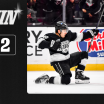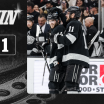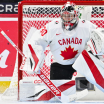Moving back to the right side, we take a look here at Jordan Spence’s second full season in the NHL. Spence played nearly the full 82-game schedule for the second straight season, as the 24-year-old defenseman
Jordan Spence
LAK Statline – 79 games played, 4 goals, 24 assists, +23 rating, 16 penalty minutes
LAK Playoff Statline – 5 games played, 1 goal, 0 assists, -1 rating, 0 penalty minutes
NHL Possession Metrics (Relative To Kings) – CF% – 56.8% (+5.1%), SCF% – 56.8% (+4.7%), HDCF% – 55.8% (-0.1%)
It was an interesting season for Spence. He had long stretches of solid play, with a few high-profile downs as well. Spence, to his credit, showed terrific response to those moments and returned very quickly to a high level of overall play. This recap will be more numbers based than most and that’s by design. Spence had a lot of numbers, one way or another, that show the way his season went.
Trending Up – Spence’s possession metrics this season were outstanding. To sum it up simply, when Spence was on the ice at 5-on-5, the Kings had a lot more of the puck and used it to create chances of decent quality. Among the 214 NHL defensemen to play at least 500 minutes this season, Spence ranked tenth in both percentage of scoring chances controlled and percentage of shot attempts. There’s a lot of value in having players who keep things moving in the right direction over 82 games. Spence was a key contributor in that area for the Kings this season when he was on the ice.
So what did the Kings get for all of those chances? With the same perimeters, Spence ranked fourth in the NHL in on-ice goals against, per/60. At 1.46, Spence placed narrowly ahead of teammate Mikey Anderson in that department, as the Kings were the only team in the NHL with three defensemen placed in the league’s Top-10. Spence is a solid defender, who uses his skating and positioning well, to compensate for being undersized for a blueliner, which limits his physicality. Sometimes, though, the best defense is a good offense and with the Kings controlling large shares of the puck with Spence on the ice, it kept the puck out of their net at an elite level.
Would like to offer one underlying number that could help support what’s above. It’s something the eye test supports and is backed up by the data. Spence was very good at getting the puck out of his own zone with puck possession. In fact, no Kings blueliner had a higher success rate of exiting the defensive zone this season via a carry-out or a pass than Spence did, at just shy of 90 percent. It all seems to jive. Spend less time in the defensive zone, move in transition with possession, generate more offensive opportunities, keep the puck out of your net. Spence, from the perspective of the numbers, faired well in those areas.
Trending Down – There was, naturally, a lot of conversation about Spence’s usage in the postseason. After averaging 16:47 in the regular season, Spence played just 7:31 on average in the playoffs. There was never a firm reason given as to why, so I’ll have to speculate a bit. In looking at the numbers, so much of what was great for Spence in the regular season went the other way in the postseason, particularly early in the series.
Among defensemen with at least five games played in the postseason, Spence’s expected goals against per/60 was the highest in the NHL. He was also on the ice for the most high-danger chances against, per/60, of any defenseman in the league. It amounted to the Kings controlling just 23.8 percent of high-danger chances with Spence on the ice. The sample size is quite small, no doubt about it. A lot of those numbers came from Game 1, which saw high-danger chances at 6-1 against him and it felt like his start to the series impacted the next several games with regards to trust from the coaching staff. I think the leash was quite short for a player who was trusted for the bulk of 82 games but the numbers don’t lie, either. Spence did have a tough first game and it seemed to set the tone, negatively, for the series as a whole.
On a wider note, Spence did set career highs this season in goals, assists and points, but overall, he saw his totals grow only minimally, especially for a player who is thought of as an offensive defenseman. Spence came into the system as a touted, offensive defenseman. During his two main seasons spent in the AHL, Spence tallied 87 points from 102 games played, which translates to 0.85 points-per-game. With the Kings this season, the number was 0.30 points-per-game. Points aren’t the end all, be all, but I do think that there has always been belief there is more in there offensively for a player with Spence’s build and skillset. It just hasn’t translated into production at the NHL level to this point.
2025-26 Status – Spence is under contract for one more season at a salary-cap hit of $1,700,000. He will be a restricted free agent at the end of the 2025-26 season. Despite the way his playoffs went, Spence said during his end-of-season interview that he wanted to be back with the Kings and wants to continue to develop and play in Los Angeles. Lots of good from his season that should be coveted and for that salary-cap hit, Spence represents a really strong value. I like Spence, as a player and for his fit in the room with this team specifically. He’s also in line for a pay increase next summer, has value around the NHL and there’s a new management team in place. As of now, I’m planning on Spence being back in a second or third pairing role on the right side, which is where he spent most of the 2024-25 season. But the business is the business and he’s one to keep an eye on heading into the summer.



















